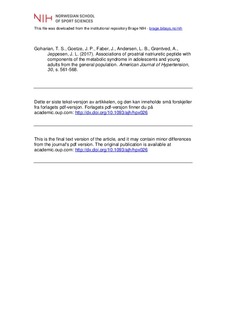Associations of proatrial natriuretic peptide with components of the metabolic syndrome in adolescents and young adults from the general population
| dc.contributor.author | Goharian, Tina S | |
| dc.contributor.author | Goetze, Jens P | |
| dc.contributor.author | Faber, Jens | |
| dc.contributor.author | Andersen, Lars Bo | |
| dc.contributor.author | Grøntved, Anders | |
| dc.contributor.author | Jeppesen, Jørgen L. | |
| dc.date.accessioned | 2018-04-20T10:13:21Z | |
| dc.date.available | 2018-04-20T10:13:21Z | |
| dc.date.created | 2017-10-11T15:35:10Z | |
| dc.date.issued | 2017 | |
| dc.identifier.citation | American Journal of Hypertension. 2017, 30, 561-568. | nb_NO |
| dc.identifier.issn | 0895-7061 | |
| dc.identifier.uri | http://hdl.handle.net/11250/2495267 | |
| dc.description | I Brage finner du siste tekst-versjon av artikkelen, og den kan inneholde ubetydelige forskjeller fra forlagets pdf-versjon. Forlagets pdf-versjon finner du på academic.oup.com / In Brage you'll find the final text version of the article, and it may contain insignificant differences from the journal's pdf version. The definitive version is available at academic.oup.com | nb_NO |
| dc.description.abstract | BACKGROUND: In middle-aged and elderly populations, circulating natriuretic peptide concentrations are negatively associated with several components of the metabolic syndrome. Whether these negative associations are also present in healthy adolescents and young adults from the general population are unknown. METHODS: In a cross-sectional setting, we measured plasma concentrations of mid-regional proatrial natriuretic peptide (MR-proANP) in 343 adolescents (age 14–16 years) and 616 young adults (age 20–28 years) from the Danish site of the European Youth Heart Study, which is a population-based study of cardiovascular disease risk factors in children, adolescents and young adults. We used linear regression analysis to examine the associations, expressed as standardized regression coefficients, of various variables of interest with MR-proANP stratified according to age group, adjusting for age and gender. RESULTS: Among the young adults, MR-proANP was negatively associated with body mass index (BMI) (β = −0.10, P = 0.02), waist circumference (WC) (β = −0.14, P < 0.001), systolic blood pressure (BP) (β = −0.08, P = 0.03), diastolic BP (β = −0.23, P < 0.001), insulin (β = −0.15, P < 0.001), and triglycerides (β = −0.14, P < 0.001). Among the adolescents a somehow different pattern was observed since MR-proANP was not significantly associated with BMI (β = −0.00, P = 0.98), WC (β = −0.01, P = 0.90) and insulin (β = −0.02, P = 0.69). Nevertheless, among the adolescents, MR-proANP was negatively associated with triglycerides (β = −0.13, P = 0.01), diastolic BP (β = −0.12, P = 0.01) and systolic BP (β = −0.10, P = 0.10), although the latter association was of borderline significance. CONCLUSIONS: The young adults displayed significant negative associations between MR-proANP and several components of the metabolic syndrome, whereas such associations were not found among the adolescents besides triglycerides and diastolic BP. | nb_NO |
| dc.language.iso | eng | nb_NO |
| dc.subject | anthropometry | nb_NO |
| dc.subject | atrial natriuretic peptide | nb_NO |
| dc.subject | blood pressure | nb_NO |
| dc.subject | body mass index | nb_NO |
| dc.subject | metabolism | nb_NO |
| dc.subject | insulin | nb_NO |
| dc.subject | natriuretic peptides | nb_NO |
| dc.subject | waist circumference | nb_NO |
| dc.title | Associations of proatrial natriuretic peptide with components of the metabolic syndrome in adolescents and young adults from the general population | nb_NO |
| dc.type | Journal article | nb_NO |
| dc.type | Peer reviewed | nb_NO |
| dc.description.version | acceptedVersion | nb_NO |
| dc.source.pagenumber | 561-568 | nb_NO |
| dc.source.volume | 30 | nb_NO |
| dc.source.journal | American Journal of Hypertension | nb_NO |
| dc.source.issue | 6 | nb_NO |
| dc.identifier.doi | 10.1093/ajh/hpx026 | |
| dc.identifier.cristin | 1503878 | |
| dc.description.localcode | Seksjon for idrettsmedisinske fag / Department of Sport Medicine | nb_NO |
| cristin.unitcode | 150,34,0,0 | |
| cristin.unitname | Seksjon for idrettsmedisinske fag | |
| cristin.ispublished | true | |
| cristin.fulltext | postprint | |
| cristin.qualitycode | 1 |
Tilhørende fil(er)
Denne innførselen finnes i følgende samling(er)
-
Artikler / Articles [2119]
